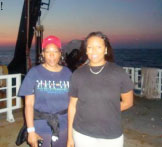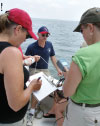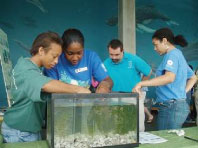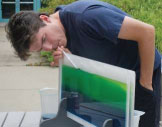 | |
A teacher and Hampton University graduate student on a Coastal Trends cruise | |
COSEE Coastal Trends is a thematic center that aims to increase literacy in ocean science, with a focus on understanding dynamic coastal trends through partnerships among scientists, educators, students, and the general public. Our center has established a number of programs that aim to encourage collaboration between science and education and to broadly disseminate scientifically accurate information about our coastal oceans. We are a relatively new center, established in 2007, and are excited about the progress we’ve made over the past year.
Unique Partnerships, Valuable Lessons
The heart of COSEE Coastal Trends is the scientist-educator partnership program, which establishes teams consisting of a scientist, a graduate student, a teacher, and a Hampton University undergraduate. The teams conduct research over the course of a summer and work together to create web-based education modules, which include science lesson plans and information on the team’s research topic. This year we formed two scientist-educator teams, one focusing on marine microbes under Dr. Dave Kirchman at the University of Delaware, and the other studying striped bass larvae in estuarine turbidity maxima, under Dr. Elizabeth North at the University of Maryland’s Horn Point Laboratory. The teams developed excellent content and lesson plans highlighting their research. COSEE Coastal Trends staff is currently working on publishing the material on our website. Check out the Modules section to see content created by last year’s scientist-educator teams, focusing on seagrass and dead zones, as well as our “Observing the Ocean” module, adapted from the ocean observing systems curriculum we developed through COSEE Mid Atlantic (a legacy Center).
| |  |
| Teachers collect water quality data during a workshop |
A multitude of valuable lessons result from these scientist-educator partnerships. First, bringing together experts in both the science and education fields literally results in the creation of robust classroom lesson plans that are scientifically rigorous and utilize proven instructional methods. In addition, evaluations have revealed that each member of the team learns important lessons during the collaborative experience. By participating in an active research project, teachers and undergraduates enhance their science content knowledge and gain skills that they can apply professionally. In addition, scientists gain a unique perspective on communicating the “big picture” concepts of their research to general audiences through close collaboration with educators.
Getting the Word Out
One way COSEE Coastal Trends is working on disseminating these web-based materials is through teacher workshops. This summer we presented our modules during hands-on workshops to more than 50 teachers from 11 states across the country. Teachers have already reported using some of the content and activities in their classrooms. We plan on conducting additional one-day in-service workshops for educators throughout the school year.
 | |
Mentors from Hampton University prepare a seagrass display | |
In addition to dissemination of our web-based education modules, which are primarily geared towards formal educators, our center also works to make coastal science come alive for informal audiences. Middle school students participating in our
Mentoring Young Scientists (MYS) program at the Virginia Aquarium learn about the module topics through hands-on activities. They then create displays for informal dissemination of the scientist-educator partnership research topics at the aquarium. Undergraduate students from Hampton University, including those participating in our scientist-educator teams, serve as mentors for the “young scientists,” creating an information pathway from scientist to students to the general public. This past April, the Virginia Aquarium held “Coastal Trends Weekend,” a special event featuring the demonstrations and displays developed by Mentoring Young Scientists participants. One group performed a puppet show about “dead zones” based on the scientist-educator team that studied hypoxia; another group, led by the undergraduate student researching seagrass, created a “seagrass jungle” from grass skirts to help children discover the importance of this ecosystem as a habitat.
Ocean Science Course and School District Partnerships
| |  |
| A teacher tries out an activity examining water density |
Finally, we have developed a curriculum for an activity-based high school level ocean science course, titled “An Introduction to Our Dynamic Ocean,” which is structured around the Ocean Literacy Principles. The course combines activities from our modules, NOAA’s Ocean Explorer program, and a number of other scientist and teacher-vetted sources. Our center is currently partnering with Maryland’s Queen Anne’s County Public Schools to pilot the course. Kris Jensen, who teaches the course, enjoys the subject “because it is so relevant to the student's lives and almost everyone finds interesting areas of inquiry in the curriculum.” He also reports that “students leave the class saying it was their favorite class of the year because they get to do a lot of interesting things.”
This past summer, we led a workshop for educators who teach ocean science to share with them the “Dynamic Ocean” curriculum. These teachers are currently piloting the course in their school districts around the country, while Queen Anne’s County is entering its second year of offering the course. As we continue to collect feedback from teachers, we hope to refine and enrich the curriculum for broader-scale dissemination.

